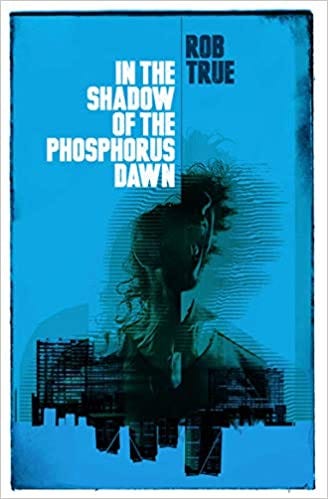Themes: Murder, Gangland, Psychedelic horror, Crime Noir, Drug abuse
Read this if: You want to read a book with brutal murders and a unique writing style
Don’t read this if: You’re not up for some graphic violence
Links to purchase: Influx Press, Amazon
At the end of every book there is the oft skipped ’About The Author’ page. Usually, it is a list of the accolades and other works by the author; a combination of a trophy case and billboard. In the case of In the Shadow of the Phosphorous Dawn, it was a useful insight into the life of the author, Rob True. It helped to answer one of the biggest questions I had while reading the book, why does this book feel so different from anything else I’ve read? The reason lies partly in the fact that Rob True is an outsider to the literary world.
Most authors’ debut novel comes when they’re in their late twenties/early thirties, hot off the back of their masters in creative writing. Rob True is 50 years old, and left school without any qualifications (for those outside the UK that means dropping out at 16 without a diploma). As per the ’about the author’ page, “His wife taught him how to use paragraphs and punctuation aged forty and he began writing stories.” Now it could be that education is irrelevant, and that he’d have arrived at the same style regardless of education, but I would guess the reality is that as much as teachers encourage students to find their voice, there is a certain amount of standardisation that happens leading to a certain amount of sameness. Rob True’s writing is unique; it’s staccato, intensely descriptive, and bordering on psychedelic. A drug induced nightmare directed by Quinton Tarantino.
That the book is as unique as it is, is even more impressive considering it starts off with a trope crime noir premise: Gangsters are being murdered, but nobody can explain who’s doing it. Enter the story’s protagonist, Carl. A man who’s left the gang life behind, until he’s pulled back in for one final job; find out who’s committing the murders. It sounds corny, but the story plays out through Carl’s battered psyche, as drug addiction and personal tragedy push him deeper into psychosis. It rapidly becomes unclear which is more terrifying, Carl’s dreams, or the world around him, even as the distinction between them becomes increasingly blurred.
“Driving out the car park, sun low in the sky and the whole scene shimmering and unreal. Gold glare reflected in windows on the block, and the houses across the way are black against the heaven aflame in the blue. Dark shadows across the quarter-light, over the tarmac and still cars parked, like a figure looming. Shadow snide. Carl drives out into the road.
A man jumps out in front of the car, arms outstretched, and he roars through a paper-bag mask, face drawn on in felt tip. Carl slams on the anchors and stares at the man crossing in front of him, like nothing had happened. Nothing is real. He pulls out onto the main road.
Rising on the horizon, stark monolith against the dusk. One of three. Many eyes of gold ablaze. Sheer face, home to falcon, preys on the rec below. Tintagel House. Home to the broke and busted. To drunks, addicts and lonely mothers. To lost losers and lunatics.”
In the Shadow of the Phosphorous Dawn is a page turner, and there’s only 180 pages to turn. For enterprising readers it could be finished in a single sitting. There is some sex and disturbing violence, which will put off some readers, but I would highly recommend it in general. There’s something to be said for a book which is so unique that after finishing your first thought is, “I probably won’t come across another book like that again.”
If the review has piqued anybody’s interest, I have a free copy to give away. First come, first serve. Just respond to my email, or comment.


